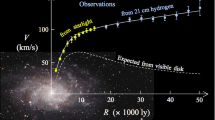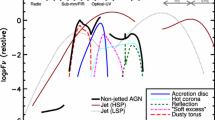Abstract
We describe the motion of a particle in acentral field in an expanding universe. Use is made ofa double expansion in 1/c and 1/τ, where c and τare the speed of light and the Hubble time. In thelowest approximation the rotational velocity is shownto satisfy v4 = 2/3 GMcH0, whereG is Newton's gravitational constant, M is the mass ofthe central body (galaxy), and H0 is theHubble constant. This formula satisfies observations of stars moving inspiral and elliptical galaxies, and is in accordancewith the familiar Tully–Fisher law.
Similar content being viewed by others
REFERENCES
Bertotte, B., and Plebanski, J. (1960). Annals of Physics, 11, 169.
Carmeli, M. (1964a). Physics Letters, 9, 132.
Carmeli, M. (1964b). Physics Letters, 11, 169.
Carmeli, M. (1964c). Annals of Physics, 30, 168.
Carmeli, M. (1965a). Physical Review, 138, B1003.
Carmeli, M. (1965b). Nuovo Cimento, 70, 842.
Carmeli, M. (1965c). Annals of Physics, 34, 465.
Carmeli, M. (1965d). Annals of Physics, 35, 250.
Carmeli, M. (1965e). Physical Review, 140, B1441.
Carmeli, M. (1982). Classical Fields: General Relativity and Gauge Theory, New York, Wiley, Chapter 6.
Carmeli, M. (1995a). Foundations of Physics, 25, 1029.
Carmeli, M. (1995b). Communications in Theoretical Physics, 4, 109.
Carmeli, M. (1995c). Communications in Theoretical Physics, 4, 233.
Carmeli, M. (1996a). Foundations of Physics, 26, 413.
Carmeli, M. (1996b). Communications in Theoretical Physics, 5, 101.
Damour, T. (1983). In Gravitational Radiation, N. Deruelle and T. Piran, eds., North-Holland, Amsterdam, pp. 59-144.
Einstein, E., and Grommer, J. (1927). Sitzungsberichte der Preussiche Akademie der Wissenschaften Physikalisch-Mathematische Klasse.
Einstein, A., and Infeld, L. (1949). Canadian Journal of Mathematics, 1, 209.
Einstein, A., Infeld, L., and Hoffmann, B. (1938). Annals of Mathematics, 39, 65.
Fock, V. (1957). Reviews of Modern Physics, 29, 325.
Fock, V. (1959). The Theory of Space, Time and Gravitation, Pergamon Press, Oxford.
Infeld, L. (1957). Reviews of Modern Physics, 29, 398.
Infeld, L., and Plebanski, J. (1960). Motion and Relativity, Pergamon Press, Oxford.
Infeld, L., and Schild, A. (1949). Reviews of Modern Physics, 21, 408.
Rights and permissions
About this article
Cite this article
Carmeli, M. Is Galaxy Dark Matter a Property of Spacetime?. International Journal of Theoretical Physics 37, 2621–2625 (1998). https://doi.org/10.1023/A:1026672604958
Issue Date:
DOI: https://doi.org/10.1023/A:1026672604958




